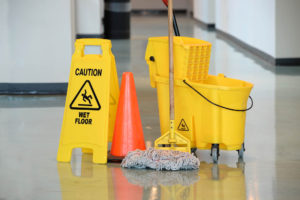Workplace Safety Topic
Slips, Trips & Falls
Slips, trips and falls account for a number of workplace injuries in Montana. Common causes run the gamut from exposed tripping hazards like cords, to a lack of snow removal in winter, to using ladders inappropriately. Common injuries include bruises, broken bones and debilitating back injuries. Fortunately, slip, trip and fall hazards all have one thing in common – they are easy to mitigate.
Mitigation begins by identifying likely hazards, such as loose stair treads, broken equipment, blocked aisles and improper clean up. Next, have your safety committee address each one thoroughly in a planned fashion. Finally, embrace a culture of safety where people look for issues and report them before they cause injury. Prevention is about understanding and a willingness to mitigate issues, and it can be helpful to have an objective eye.
Please check out our video, safety tips and resources or contact our safety services professionals for more information.
MORE SAFETY VIDEOS
Getting Started:
 The causes of slips, trips and falls come in a wide variety. Addressing them all immediately can be overwhelming. So, start by asking yourself which of the following is most likely to cause falls in your workplace as you look around today:
The causes of slips, trips and falls come in a wide variety. Addressing them all immediately can be overwhelming. So, start by asking yourself which of the following is most likely to cause falls in your workplace as you look around today:
- Poor Housekeeping.
- Wet or slippery surfaces.
- Obstacles in aisles and walkways.
- Inadequate lighting.
- Improper footwear.
You may find that several of these pose a threat to you or your employees. If so, begin with the basics: good housekeeping. It may seem obvious, but many falls can be prevented by cleaning up spills and debris and removing clutter. Start in the highest traffic areas, with the most obvious problems. That might be scrap material or waste that has accidentally collected, power cords that cross walkways, or break room coffee spills. Once you’ve addressed these trouble spots with better housekeeping, you can address the deeper issues that cause falls using the resources below. And you’ll likely have saved an employee from injury in the meantime.
 Report an Injury
Report an Injury Get Coverage
Get Coverage Manage Policy
Manage Policy Pay Bill
Pay Bill










